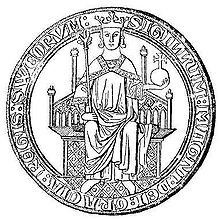Magnus Ladulås: Difference between revisions
Date/fix the maintenance tags or gen fixes |
Question: I have never before seen the theory that Magnus' nickname was derived from Ladislaus -- that theory sound like it originates with Monty Python or Spamalot -- I have not made an edit but I a |
||
| Line 1: | Line 1: | ||
{{Unreferenced|date=April 2007}} {{Not verified|date=July 2007}} |
--[[User:Donkey99|Donkey99]] 02:20, 23 August 2007 (UTC){{Unreferenced|date=April 2007}} {{Not verified|date=July 2007}} |
||
[[Image:Magnus Ladulas sigill.jpg|thumb|Seal of king Magnus]] |
[[Image:Magnus Ladulas sigill.jpg|thumb|Seal of king Magnus]] |
||
'''Magnus III Birgersson''' ([[1240]]–[[1290]]), usually called '''Magnus Ladulås''' (Magnus ''Barnlock''), was [[monarch|king]] of [[Sweden]] from [[1275]] until his death in 1290. |
'''Magnus III Birgersson''' ([[1240]]–[[1290]]), usually called '''Magnus Ladulås''' (Magnus ''Barnlock''), was [[monarch|king]] of [[Sweden]] from [[1275]] until his death in 1290. |
||
Revision as of 02:20, 23 August 2007
--Donkey99 02:20, 23 August 2007 (UTC)
This article needs additional citations for verification. (July 2007) |

Magnus III Birgersson (1240–1290), usually called Magnus Ladulås (Magnus Barnlock), was king of Sweden from 1275 until his death in 1290.
He is the first Magnus to rule Sweden so that posterity recognizes him as legitimate king and not generally regarded as a usurper or a pretender (but third Magnus to have been proclaimed Sweden's king and ruled there). Later historians ascribe his epithet "Ladulås" to a decree of 1279 or 1280 freeing the yeomanry from the duty to provide sustenance for travelling nobles and bishops ("Peasants! Lock your barns!"); another theory is that it's simply a corruption of Ladislaus, which could possibly have been his second name, considering his Slavic heritage.
The Alsnö stadga (Ordinance of Alsnö) from 1279 or 1280 also gave anyone who undertook to provide the Crown with a mounted warrior (knight) and a warhorse, the freedom from certain taxes (such a liberty was called frälse in Swedish). This is often said to be the foundation of the Swedish nobility, although the gradual development of this privileged group into a hereditary class would take centuries and not become formalized until long into the 16th century.
Magnus was the second son of Birger jarl (Birger Magnusson, 1200-66) and Ingeborg Eriksdotter of Sweden, herself the youngest sister of the childless king Eric XI of Sweden, and the youngest daughter of Eric X of Sweden and Richeza of Denmark. His father designated Magnus as his successor in powers of the jarl, henceforward titled Duke of Sweden. The elder brother, Valdemar I of Sweden had become the king succeeding their maternal uncle in 1250.
In 1275, duke Magnus started a rebellion against his brother with Danish help, and ousted him from the throne. Instead, Magnus was elected King at the Stones of Mora. In 1276, Magnus Ladulås married his second wife Helvig of Holstein, daughter of Gerhard I of Holstein (through her mother Elisabeth of Mecklenburg, she was a descendant of Christina, the putative daughter of Sverker II of Sweden, and of Ulvhild of Saxony, a descendant of Astrid Olofsdotter, Queen of Norway and daughter of Olof I of Sweden). A papal annulment of Magnus' first marriage and a dispensation for his second (necessary because of consanguinuity) were issued ten years later, in 1286. Helvig later acted as Queen Regent, probably 1290–1302 and 1320–1327.
The deposed king Valdemar managed, with Danish help in turn, to regain provinces in Gothenland, the southern part of the kingdom, and Magnus had to recognize it in 1277. However, Magnus regained them c. 1278 and assumed officially the additional title rex Gothorum, King of the Goths, starting the tradition of "King of the Swedes and the Goths".
King Magnus' youngest brother Benedict, then archdeacon, acted as his Lord High Chancellor of Sweden, and in 1284 Magnus rewarded him with the Duchy of Finland.
He died when his sons were yet underage. Magnus ordered his kinsman Torgils Knutsson, the Lord High Constable of Sweden as the guardian of his heir, the future king Birger of Sweden, who was about ten years old at father's death.
Children of his second marriage to Helvig of Holstein
- Ingeborg Magnusdotter of Sweden, born abt. 1279. Married King Eric VI of Denmark, Erik Menved.
- Birger Magnusson, born abt. 1280, king of Sweden.
- Eric Magnusson, Duke of Södermanland in 1302 and Halland etc c 1305, born abt. 1282. Died of starvation 1318 at Nyköpingshus castle while imprisoned by his brother King Birger.
- Valdemar Magnusson, Duke of Finland in 1302 and Öland 1310. Died of starvation 1318 at Nyköpingshus castle while imprisoned by his brother King Birger.
- Rikissa Magnusdotter, abbess of the convent of Sta Clara at Stockholm. Died after 1347.
